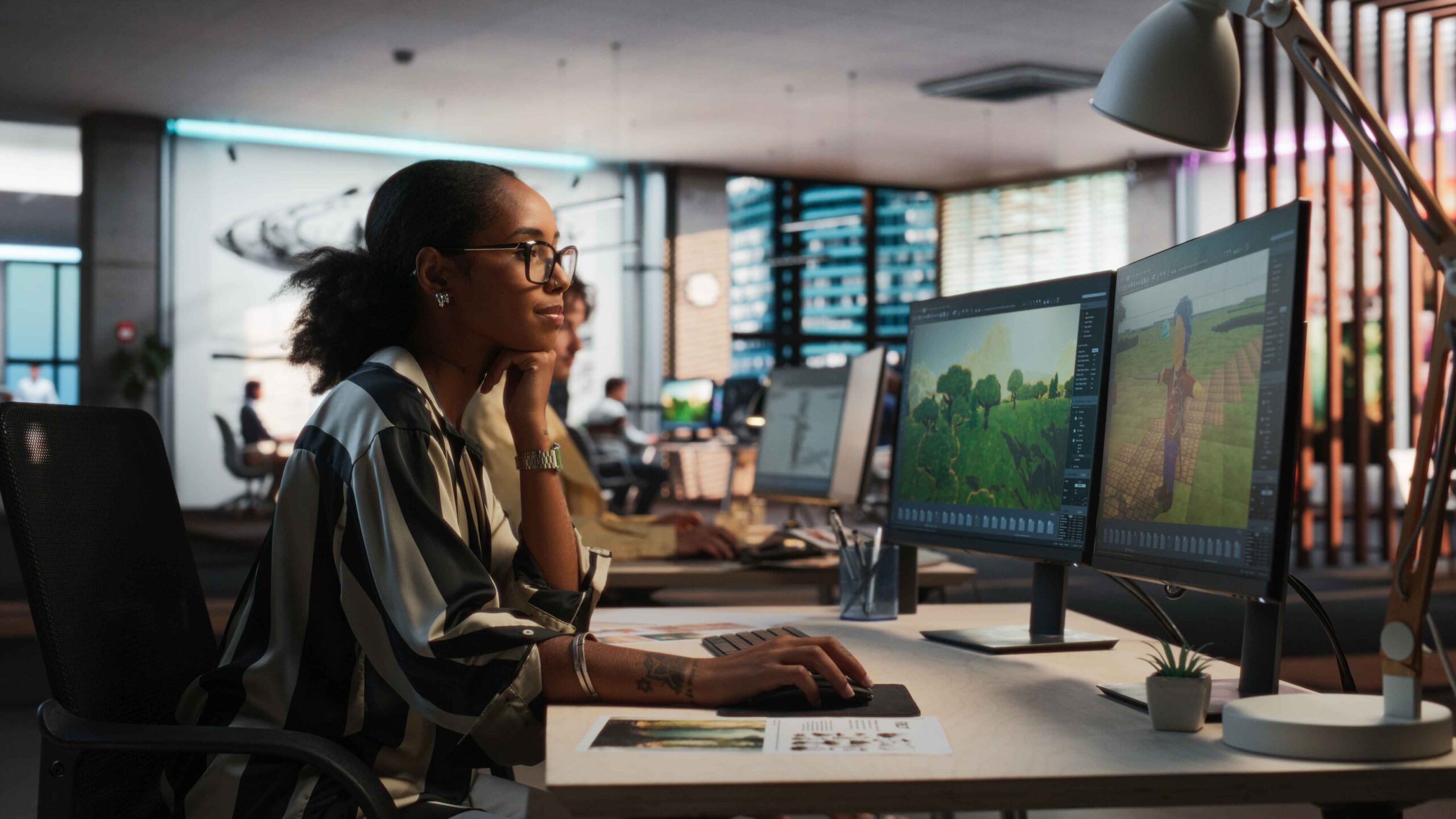Want to make a lasting impression as you begin applying for jobs in the gaming industry? Presenting potential employers with samples of your best work in the form of a game art portfolio is a must.
If you’re just starting out in the gaming industry, the process of building up an expansive digital art portfolio may seem daunting. Fortunately, there are some practical tips you can keep in mind as you begin growing your portfolio — and being enrolled in the right game art design program can provide you with plenty of opportunities to showcase work you can be proud of.
The Essentials of a Game Art Portfolio
In some industries, having a great resume alone may be enough to land you an interview. In the gaming world, however, employers want to be able to see more than just your accolades and designations; they want to see samples of your work to get a better idea of whether your artistic style and talent lines up with what they’re looking for. This is where the digital design portfolio comes in.
What to Include in Your Portfolio
So, what should you include in a gaming portfolio? Ultimately, this will depend on the specific area of the field where you wish to work. In general, though, a gaming art portfolio should include a few samples of your absolute best work. This could be anything from a game art rendering to a 3D model or character design. Ideally, you’ll display all of this on a game artist portfolio website so that you can easily update the content and share your work as needed.
In addition to samples of your best work, your portfolio should include your contact information. This may seem obvious, yet this information can be forgotten when you’re focused on choosing the right pieces to showcase.
Tailoring Your Portfolio to Your Target Audience
Just as you would tailor a resume to a specific job posting, it’s also a good idea to customize your gaming portfolio based on the job you want. For example, if you’re applying for a specific job with a company that has a very defined artistic style, you’ll want to hand-select pieces of your own work reflecting that unique style. If you are applying for multiple jobs at the same time, this may require you to create multiple versions of your online portfolio.
Structuring Your Portfolio
Choosing a few of your best game art portfolio examples and publishing them to an online portfolio isn’t necessarily enough to impress potential employers. You should think carefully and critically about how your portfolio is structured as well as how you display each piece in sequence.
Creating a Clear and Intuitive Layout
Remember, your gaming portfolio should showcase not just your best artistic talent, but your ability to design in a way that is thoughtful, intuitive, and user-friendly. This means that your portfolio website should be well-designed and easy to navigate. Anyone viewing your portfolio should be able to quickly find the information they need. Typically, this means keeping your portfolio design relatively simple without too many bells and whistles that could be distracting.
Showcasing Your Best Work First
When choosing pieces to showcase in your portfolio, you’ll also want to put your best work at the top of the page so that prospective employers see it first. The people responsible for hiring probably see dozens (if not more) of gaming portfolios each day. You may have seconds to catch their eye.
With this in mind, they may not spend a great deal of time sifting through every single sample in your portfolio. This is precisely why it’s so crucial to present your very best and most relevant work upfront so they can easily see it without having to dig around. In this sense, showcasing your best work first and foremost demonstrates respect for the hiring team’s valuable time.
Building a Portfolio for Career Opportunities
When you’re creating a game artist portfolio website in the hopes of landing a job, there are some other factors worth considering to help your portfolio potentially stand out from the competition.
High-Quality Visuals and Renders
First, remember that quality will win over quantity when it comes to samples in a gaming portfolio. If your work doesn’t look like it could have come straight out of a current game, it’s likely not worth including in your portfolio — especially considering that this may be your only chance to leave an impression on a prospective employer.
Including Process Work and Breakdown
Employers are often interested in seeing not just the finished product you created (or helped to create) but also the process work that helped you get there. Therefore, it’s not a bad idea to include process work and breakdowns along with some of your completed pieces, particularly if this work showcases how you solved a problem or made a major contribution.
Building a Portfolio From Professional Work
As you actually begin working in the gaming industry, you’ll naturally begin to expand your portfolio with new creations. Assuming you have the legal right to publish this work in your portfolio, you should continue adding pieces to your professional portfolio as a way of keeping it relevant. After all, you never know when another exciting career opportunity or chance at an internal promotion may arise — so you’ll want your portfolio to be ready at any time.
Portfolio Website vs. Art Platforms for Showcasing Professional Projects
Your updated portfolio should live on your professional website, but there are situations where you may also want to share your portfolio (or pieces from it) elsewhere. In these instances, sharing samples of your work to a reputable art platform may be the answer. Sites like Behance, DeviantArt, Dribble and ArtStation are all great outlets to share professional projects and build a following. Some of these platforms even hold special contests and allow artists to receive community feedback, which can be valuable in portfolio assessment and improvement.
Online Portfolio Builders and Customization for Professional Work
If you’re not sure where to begin when it comes to actually creating your online portfolio or website, the good news is that there are plenty of easy-to-use online portfolio builders that can walk you through the process (and do a lot of the complex coding for you). With platforms such as Squarespace, Crevado, Wix and Pixpa, you can choose a portfolio template and then customize it to your liking before uploading samples of your own work.
Best Practices for Promoting Your Portfolio
Even once your portfolio is complete, your work isn’t done. Aside from sharing the link to your portfolio on any job applications, you also want to be proactive in promoting your work among (and beyond) your professional circle.
Keeping Your Portfolio Updated
One key consideration to keep top of mind when maintaining and promoting a portfolio is that it will ideally be updated and ready for potential employers or partners to view at any time. This means that whenever you have a new sample to show off, you should publish it to your portfolio website right away.
Using Social Media to Promote Your Work
Social media can be an excellent platform for sharing and promoting your work with a wide audience, so be sure to leverage it to your advantage. In addition to social media sites like Facebook, Instagram, TikTok and X, also set up profiles on professional networking sites like LinkedIn. From there, you can build connections and potentially find work opportunities — all by sharing your work with others.
Common Mistakes to Avoid
Finally, as you begin working on your digital art portfolio, there are some common mistakes you’ll want to be careful to avoid.
Overloading Your Portfolio With Too Much Content
One of the biggest mistakes that gaming students make is assuming that more portfolio content is always better. Again, this harkens back to remembering that the people hiring for gaming jobs are typically busy with many portfolios and resumes to review. By having just a few samples of your absolute best work (as opposed to a dozen mediocre samples), you can make sure that only your highest-quality art is seen.
How many projects is too many? According to a 2022 study, prospective employers prefer to see anywhere from four to seven samples in a design portfolio and will spend anywhere from 25 to 30 minutes viewing a single portfolio.
Poor Presentation and Inconsistent Quality
You’ll also want to make sure that your work is presented in a way that is easy for people to navigate and find what they’re looking for. Aside from showcasing your best pieces up front, ensure that your contact information or biography section is readily visible as well. From a quality standpoint, remember that this could be your only chance to make a lasting impression — so it’s essential that all photos, renderings and samples are of the highest quality possible.
Start Your Game Art Portfolio at RMCAD
Building a portfolio for game concept art, 3D modeling, or character design is a task you’re never fully done with; you should update and refine your portfolio throughout your entire career. Still, with the above game design portfolio tips in mind, you can put your best foot forward as you apply for jobs in this exciting yet competitive industry. Seeking the right degree program to prepare you for a career in gaming? The game art bachelor’s degree program at Rocky Mountain College of Art + Design covers such foundational skills as 3D modeling, visual storytelling, environment design, character rigging and more. This program is offered in both on-campus and online formats to suit your needs and lifestyle. Learn more about this or any of our other programs by dropping us a line, or get started with your admissions application today.

